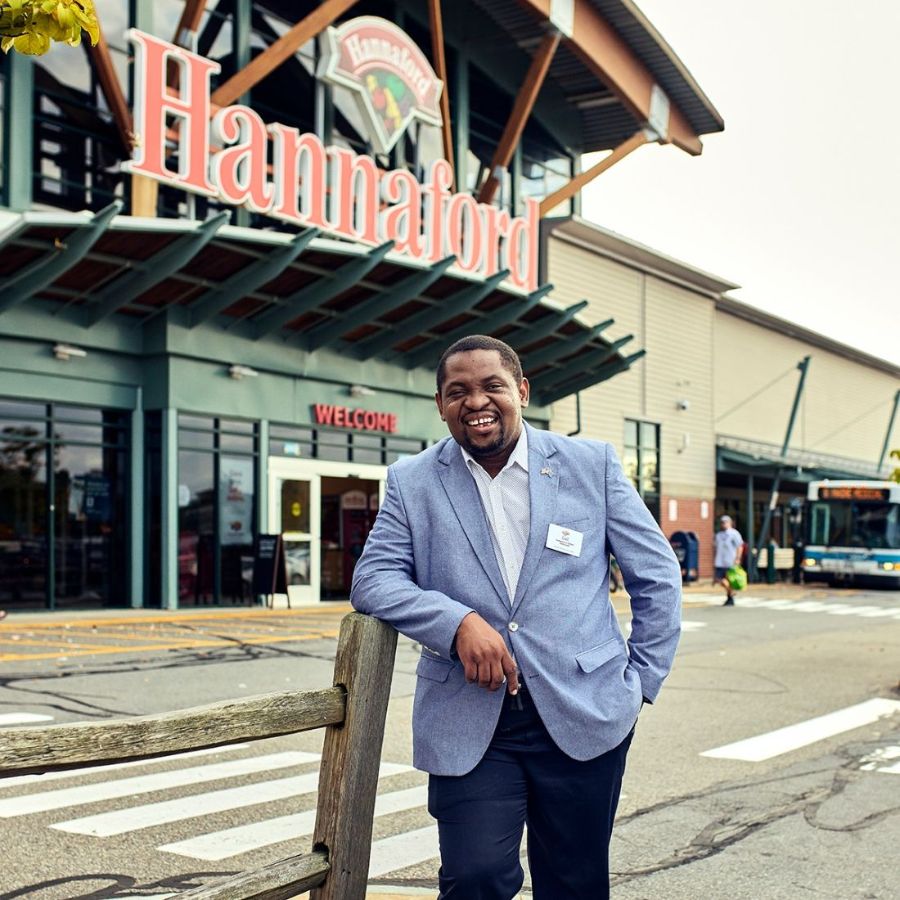As part of our Sustenance series that explores trends in Maine’s food economy, we sat down with Luc Samuel Kuanzambi to talk about accessing good food in Maine from the perspective of a new Mainer. In his former role as Cultural Ambassador for Hannaford, Luc discussed the opportunities for grocers and food producers to better meet the needs of Maine’s growing immigrant community. Along the way, we learned a lot about Central African cuisine.

Luc Samuel Kuanzambi moved his family to Portland from the Democratic Republic of the Congo in 2017 to seek urgent medical care for one of his children. With a background in public and diplomatic relations, Luc began working with the Congolese Community Association of Maine and the Immigrants’ Rights Coalition to connect asylum seekers to community resources, and later played a vital role in shaping and leading Hannaford’s Cultural Ambassador Program. Kuanzambi is a community activist, interpreter, and entrepreneur.
What is a Cultural Ambassador and how did you get involved in Hannaford’s Cultural Ambassador Program?
A cultural ambassador becomes the flag bearer for a specific culture to help immigrants feel welcome in the stores, locate specific products, and navigate the financial instruments, currency, and language barriers.
I was invited by leadership at Hannaford in 2019 to participate in a series of brainstorming sessions with community leaders to help develop a community-oriented position tasked with meeting the needs of the new arrivals in Maine, especially asylum seekers. In the sessions, we identified cultural brokering as a key cog of the program. When it came time to launch the Cultural Ambassador program, they needed feet on the ground and offered me a position as one of the earliest recruits.
What does this look like in practice?
The easiest thing to do is greet everyone that enters the store. That’s when we’ll be able to identify linguistic trends. We may not be able to speak their language, but if we can identify it, we can determine what support may be needed. We also look for those just getting off the bus with vouchers in hand from programs like General Assistance, Women, Infant, Children (WIC), and Electronic Benefits Transfer (EBT) cards. By identifying the instrument they’re carrying, we can make it easy for them to start the transactions.
Often our assistance is met with statements like “Praise God!” Why? Because they were desperately in need of help at the moment. If you’re from Afghanistan, for example, and you walk into a grocery store and find someone from Afghanistan who speaks your language there to help you, you immediately identify with this person. It creates a click, a connection, a cultural bridge.
I remember this couple. I believe they were from Angola because they spoke Portuguese. One of the earliest things immigrants are told to do when arriving in Maine is to get groceries, especially for the babies. I overheard the wife speak a few words in Lingala to the husband. I speak Lingala, so I approached them and asked them if they needed help. They wanted to know what the voucher they were carrying was for. I not only translated the paperwork but also guided them to the section of the store where they would be able to find all the items they needed, from baby formula to vegetables to household items.
My role even went a little beyond the store. I helped them find transportation from the store to the hotel. They loaded all the groceries into the vehicle and were down the road to their new life. In a sense, we’re helping people transition, at least for the very first day, into this community and helping them to feel welcome. That’s a strategic role to play and a very fulfilling one.
What opportunities exist to better meet the consumer preferences and needs of New Mainers?
Over time Hannaford has taken steps to add more ethnically relevant items to the shelves. For populations from Central Africa, there are some core shared foods like fufu, made from ground cassava or other root vegetables. We use it with stews and soups. Fufu means the world to most Africans because it’s filling. In times of economic hardship, an affordable, filling dish is the only thing that will make you feel like you did not skip a meal the entire day. Plantains are another example of a shared staple item. Boxes and boxes will sell out overnight because plantains can be used to make so many different dishes.
What dietary challenges exist for immigrant populations?
We struggle with our kids adjusting to McDonald’s and Burger King. They’d rather eat french fries and a cheeseburger than dishes from back home. If they’re young or born in America, they will know absolutely nothing of the foods we ate back home.
Besides nostalgia, I think part of the concern of the immigrant population is having access to the foods that they’re familiar with, as well as foods that they know how to use to build their health. There’s a growing population of immigrants with obesity in America. The food that’s made available in the US is attractive, but it’s not part of our natural diet. Take cheeseburgers from McDonald’s–the volume of salt is just not healthy. Africans tend to go around that by sticking to foods from home.
What’s your favorite Maine Food? What’s your favorite dish in general?
My family eats a lot of shrimp. We had access to it in the Congo, but it has become our thing in Maine. My wife likes to fix shrimp and chicken teriyaki. My oldest son and I are into lobster. Whenever I take him to the Forest Avenue Hannaford store, we watch the lobsters in the tank. Personally, my tastes are changing with age, but I’ve always liked fumbwa. It’s a Central African dish made of wild leafy greens mixed with peanut butter. It’s very tasty.

